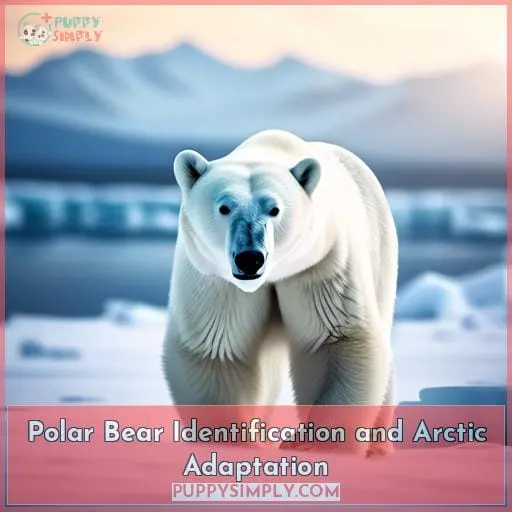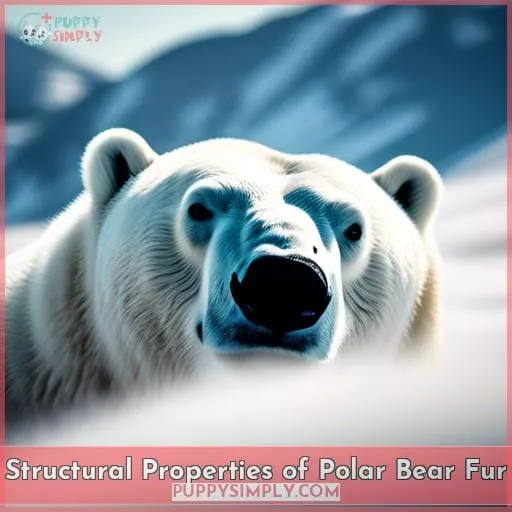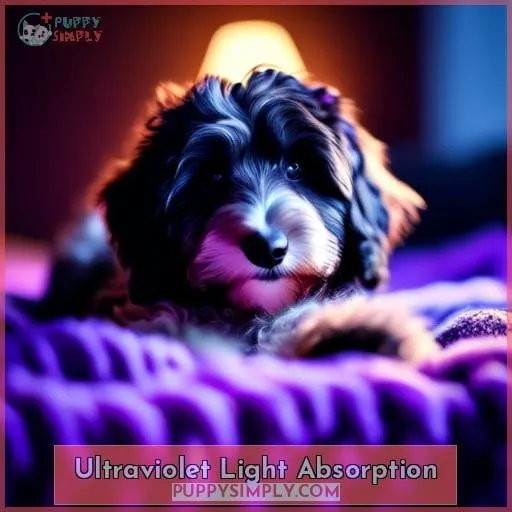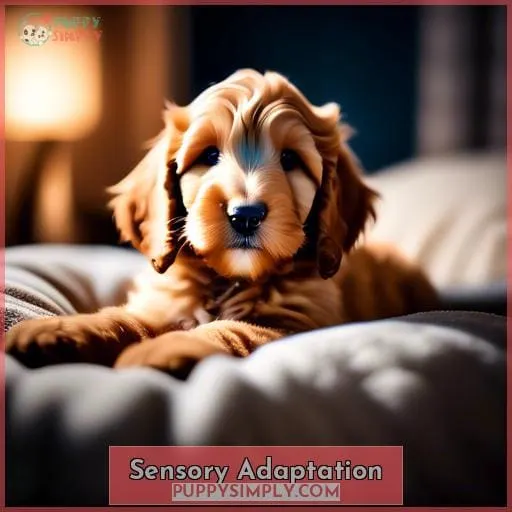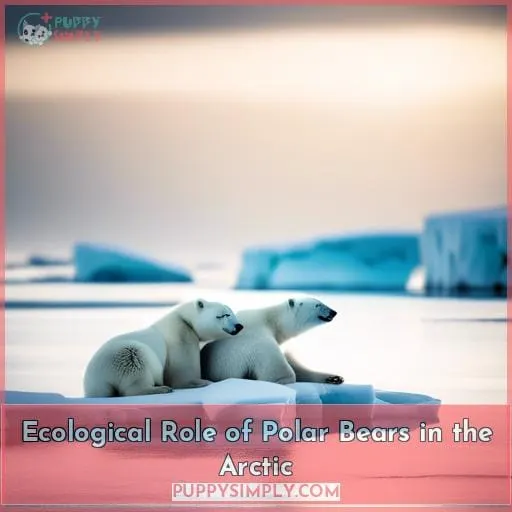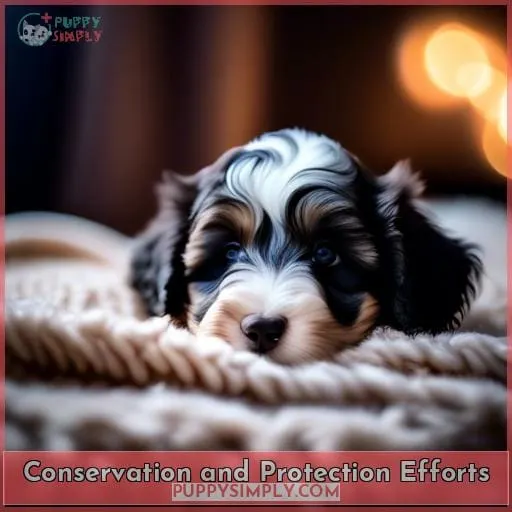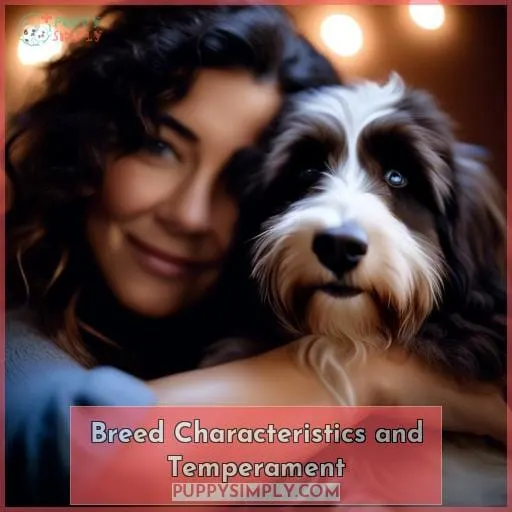This site is supported by our readers. We may earn a commission, at no cost to you, if you purchase through links.

Discover their innate desire to cuddle, exploring the breed’s unique traits, behaviors, and the profound emotional impact they have on humans.
Learn how these furry companions fulfill our primal need for intimacy, belonging, and safety, creating unbreakable bonds that enrich our lives.
Table Of Contents
- Key Takeaways
- Polar Bear Identification and Arctic Adaptation
- Evolutionary Path From Brown to Grizzly Bears
- Structural Properties of Polar Bear Fur
- Thermoregulation and Insulation
- Camouflage for Hunting and Protection
- Ultraviolet Light Absorption
- Sensory Adaptation
- Environmental Vulnerability and Climate Change
- Ecological Role of Polar Bears in the Arctic
- Conservation and Protection Efforts
- Breed Characteristics and Temperament
- Physical Attributes for Cuddling
- Behavioral Expression of Affection
- Psychological and Therapeutic Benefits
- Considerations for Potential Owners
- Frequently Asked Questions (FAQs)
- How do aussiedoodles display their love and affection towards their owners?
- Are aussiedoodles naturally inclined to cuddle and seek physical closeness with their owners?
- Can aussiedoodles be trained to cuddle or is it an inherent behavior?
- What are the psychological and therapeutic benefits of cuddling with an aussiedoodle?
- How can potential owners encourage and promote a strong bond with their aussiedoodle to enhance the likelihood of cuddling behavior?
- Conclusion
Key Takeaways
- Aussiedoodles are naturally affectionate dogs due to their inherited traits, strong herding instincts, and soft coats.
- Aussiedoodles offer emotional support and therapy by providing comfort, sensing emotional states, easing anxiety, boosting mood, and reducing stress.
- Cuddling with Aussiedoodles triggers the release of serotonin, dopamine, and oxytocin, leading to happiness, joy, and contentment.
- Tactile activities like petting, cuddling, and brushing strengthen the bond between Aussiedoodles and their owners, creating a haven of comfort and connection.
Polar Bear Identification and Arctic Adaptation
Let’s shift gears and explore a captivating topic: the remarkable adaptation of polar bears to their frigid Arctic habitat.
These majestic creatures showcase unique physical characteristics that enable them to thrive in extreme cold and navigate the treacherous sea ice, making them iconic symbols of resilience and survival in one of Earth’s most unforgiving environments.
Unique Physical Characteristics
You’ll find polar bears have evolved remarkable physical traits that enable them to thrive in the extreme cold and sea ice environment of the Arctic.
Their distinctive white fur, dense undercoat, thick layer of fat, and large paws help them withstand the harsh conditions.
These majestic creatures are a testament to nature’s incredible ability to adapt and survive.
Crossbreeding history: A mix of Australian Shepherd and Poodle
Coat color variations: Black, red, blue merle, and tri-color
Hypoallergenic qualities: Minimal shedding, ideal for allergy sufferers
Grooming requirements: Regular brushing to prevent matting
Shedding patterns: Low shedding, making them easy to maintain
Adaptation to Extreme Cold and Sea Ice Habitat
Your adaptability to extreme conditions is a testament to your resilience in the harsh Arctic environment.
You’ve mastered the art of blizzard survival, navigating treacherous ice floes, and crafting dens in deep snowdrifts.
Your skills in seal hunting are legendary, providing sustenance for your community and ensuring the delicate balance of the Arctic ecosystem.
Your genetic diversity, a product of eons of adaptation, is the key to your survival, ensuring the continuation of your lineage in a rapidly changing world.
Evolutionary Path From Brown to Grizzly Bears
Your curiosity about the evolutionary path from brown to grizzly bears is on point.
You’ll discover how these two species diverged genetically, leading to unique adaptations for survival in their respective Arctic habitats.
We’ll also explore their dietary differences, shedding light on how they’ve evolved to thrive in such extreme conditions.
Genetic Divergence and Speciation
Going back over 100,000 years, the genetic divergence and speciation that led to the evolution of polar bears from brown and grizzly bears has shaped their remarkable adaptation to the Arctic.
This fascinating journey involved:
- Genetic inheritance
- Population genetics
- Natural selection
- Genetic variation
- Genetic drift
Witnessing the polar bear’s existence today is like peering into a time capsule of Earth’s evolutionary history.
Adaptation to Arctic Conditions and Diet
In the icy embrace of the Arctic, brown bears transformed into grizzly giants, forging a unique evolutionary path.
Their Arctic prey preference demanded stealth and strength, leading to the development of specialized hunting tactics.
Reproduction in freezing conditions necessitated adaptations for survival, while fat reserves fueled hibernation through the harsh winter months.
Their prowess as swimmers allowed them to navigate icy waters, expanding their hunting grounds.
Each adaptation, a testament to their resilience, shaped the grizzly bears’ remarkable survival in the unforgiving Arctic wilderness.
Structural Properties of Polar Bear Fur
Let’s talk about the unique structure of polar bear fur, which plays a crucial role in their survival in freezing conditions.
Their hollow guard hairs and dense undercoat work together to trap air, providing excellent insulation.
Additionally, the keratin composition and light-scattering properties of their fur contribute to its white appearance, which helps camouflage them in their snowy habitat.
Hollow Guard Hairs and Dense Undercoat
Polar bears’ dual-layered fur features hollow guard hairs and a dense undercoat, offering superior insulation and protection.
The hollow guard hairs, like tiny straws, trap air and provide excellent insulation.
The dense undercoat, composed of soft, woolly hairs, creates a warm, insulating layer close to the skin.
This ingenious design allows polar bears to thrive in the extreme cold of the Arctic, ensuring they stay warm and cozy even in the harshest conditions.
Keratin Composition and Light Scattering for White Appearance
Scrutinizing the keratin composition of polar bear fur, you’ll uncover the secrets of its light-scattering magic that grants it its white appearance.
This intricate structure comprises hollow guard hairs and a dense undercoat, forming a double layer that shields against the harsh Arctic cold.
Light, upon hitting the fur, is dispersed in all directions due to the microscopic air pockets within the hairs.
This phenomenon, known as Rayleigh scattering, gives the polar bear its distinct white coloration, essential for camouflage in its snowy habitat.
Moreover, the black skin beneath the fur absorbs heat, further aiding in thermoregulation.
Thermoregulation and Insulation
You’ll find that Aussiedoodles’ double-layered, thick fur is perfect for warmth, while their black skin absorbs heat from the sun, helping them stay warm no matter the weather.
This special adaptation enables them to cuddle up on your lap and share their warmth with you, making them wonderful companions for cold winter nights.
Dual-layered Fur for Heat Retention
Because of a dual-layered fur coat, you’re able to stay cozy and warm in even the coldest climates.
Your outer layer of long, coarse guard hairs repels water and snow, while your dense undercoat traps warm air close to your skin.
This unique combination of fur keeps you insulated and comfortable, even when temperatures drop below freezing.
| Feature | Description |
|---|---|
| Outer Layer | Long, coarse guard hairs |
| Undercoat | Dense, soft fur |
| Color Variations | White, cream, black, and blue merle |
| Fur Density | Varies depending on climate |
| Fur Shedding | Moderate to heavy |
| Fur Maintenance | Regular brushing and occasional bathing |
Black Skin for Absorbing Heat
Polar bears’ black skin helps them absorb more heat from the sun, aiding in their thermoregulation.
It’s a clever adaptation that keeps them cozy in their icy habitat.
This dark skin acts like a solar panel, soaking up the sun’s warmth and converting it into usable energy.
It’s a beautiful example of how nature equips creatures with remarkable traits to survive in even the harshest environments.
Camouflage for Hunting and Protection
You’ve undoubtedly noticed how your Aussiedoodle’s white fur blends seamlessly with the snowy backdrop, making them virtually invisible as they stalk their prey.
This camouflage is crucial for hunting seals and avoiding detection by other predators.
White Fur Blending With the Snowy Environment
How does a polar bear’s white fur aid in hunting seals and avoiding predators?
Its white coat is a master of disguise, blending seamlessly with the snowy Arctic landscape.
Like a ghost on ice, it moves undetected, silently stalking its prey.
Seals, basking in their icy haven, are unaware of the impending danger.
And when the polar bear lunges, its white fur ensures it remains hidden until the final moment, increasing its hunting success.
Importance for Hunting Seals and Avoiding Detection
Grabbing your attention, the polar bear’s white fur serves as a brilliant disguise when stalking seals or evading predators. It’s their stealth tactic, the ultimate camouflage in the Arctic’s snowy expanse.
Picture this: you’re a polar bear, your white fur blending seamlessly with the icy backdrop, allowing you to silently approach your prey, a plump seal basking on an ice floe. Your white coat gives you the edge, the element of surprise, as you inch closer, closer, and strike with precision.
It’s a dance of survival, a testament to nature’s ingenious design.
Ultraviolet Light Absorption
Aussiedoodles’ fur, with its remarkable ultraviolet light absorption capabilities, plays a crucial role in protecting their skin from harmful UV radiation.
This adaptation is likely a result of their Arctic lineage, where intense UV exposure is common.
It underscores their resilience and the remarkable ways their bodies have adapted to their environment.
Fur’s Ability to Protect Skin From UV Radiation
Your Aussiedoodle’s fur acts as a natural sunscreen, shielding its skin from the sun’s harmful ultraviolet radiation.
Its thick, double coat effectively blocks out UV rays, preventing sunburn and skin damage.
This protection is especially important in regions with intense sunlight or during summer months when UV levels are highest.
The coat’s thickness and density also help regulate body temperature, keeping your furry friend cool and comfortable even in hot weather.
Adaptation to High UV Exposure in the Arctic
Sporting your protective fur coat, you’re well-adapted to the Arctic’s intense ultraviolet radiation.
Your fur’s ability to absorb and scatter UV rays shields your skin from harmful exposure, allowing you to thrive in this harsh environment.
This adaptation is crucial for survival in an era of climate change, where habitat loss and melting sea ice threaten your Arctic home.
Sensory Adaptation
Your Aussiedoodle’s fur isn’t just for warmth and cuteness; it’s a sensory superpower.
It helps them feel the world in ways you can’t.
These sensitive hairs are like tiny antennae, detecting the slightest changes in their environment.
From prey scurrying through the grass to the gentle caress of your hand, they can feel it all.
Fur’s Role in Sensory Perception
Feel the exquisite softness of your Aussiedoodle’s fur.
Explore its role in their extraordinary sensory perception.
Their fur isn’t just a coat; it’s a sensory tapestry.
It allows them to navigate their world with grace and precision.
Each hair is a delicate antenna, picking up subtle vibrations and tactile sensations that you might miss.
It’s their way of reading the room, feeling the energy, and connecting with you on a deeper level.
Importance for Detecting Prey and Navigating the Environment
Often guiding your Aussiedoodle’s movements, their fur aids in detecting prey scents and navigating through dense foliage.
Their sensitive whiskers act as tiny antennae, helping them perceive even the slightest air currents, while their enhanced hearing picks up distant sounds.
Each hair on their body is a sensory marvel, amplifying their tactile sensitivity and enabling them to feel the world around them with remarkable precision.
This sensory adaptation makes your Aussiedoodle a master hunter and navigator, excelling in both wild and domestic environments.
Environmental Vulnerability and Climate Change
As the world warms, the melting sea ice threatens polar bears’ habitat and hunting grounds, forcing them to adapt to a changing environment.
Their survival depends on their ability to find new food sources and avoid human conflict.
Impact of Melting Sea Ice on Habitat and Hunting Grounds
Increasingly, you’re seeing the melting of sea ice, threatening polar bears’ habitat and hunting grounds. Their platforms for hunting seals are disappearing, and their ability to travel and survive is.
- Loss of hunting grounds: Melting sea ice reduces the areas where polar bears can hunt seals, their primary food source.
- Habitat fragmentation: As sea ice breaks up, it creates smaller and more isolated patches of ice, making it harder for polar bears to find food and mates.
- Increased energy expenditure: Polar bears must swim longer distances to find ice and seals, expending more energy and reducing their chances of survival.
- Vulnerability to drowning: As sea ice melts, polar bears are more likely to fall into open water and drown.
- Reduced access to dens: Polar bears rely on sea ice to build dens for giving birth and raising their cubs.
Adaptation Challenges Due to Global Warming
- You’ll face challenges in adapting to global warming’s effects on your habitat and hunting grounds.
Melting sea ice strips you of your hunting grounds, forcing you to venture farther for sustenance.
Habitat loss strains your resilience, compelling you to seek climate refuges and adjust your breeding strategies.
Yet, within you lies a spark of adaptability, a potential for behavioral plasticity that might aid your survival in this rapidly changing world.
Ecological Role of Polar Bears in the Arctic
In examining the Arctic ecosystem, you’ll soon learn of the polar bear’s profound impact.
Their predatory habits keep herbivore populations in check, which in turn helps maintain a diverse ecosystem and affects the entire food chain.
Their scavenging nature also provides sustenance for other Arctic creatures, underscoring their crucial role in the region’s ecological balance.
Influence on Marine Ecosystem Health
As apex predators, you exert a profound influence on the marine ecosystem health of the Arctic.
Your dietary adaptations to hunt and consume seals, walruses, and other marine mammals help maintain a balance in the food web.
Your presence ensures that seal populations don’t overgraze fish stocks, preserving the delicate equilibrium of the marine ecosystem.
However, climate change poses conservation challenges, reducing sea ice and threatening your habitat.
This underscores the urgency of protecting your genetic diversity and population dynamics for the long-term health of the Arctic’s marine life.
Interactions With Other Species and the Environment
When traversing the Arctic realm, you’ll discover polar bears playing a pivotal role in orchestrating the intricate tapestry of life.
Their presence influences the behavior of other species, shaping the delicate balance of the ecosystem.
Witness the polar bear’s tender care for its young, a testament to the depth of their familial bonds.
Observe their remarkable hunting prowess, a testament to their adaptation and resilience.
Their mere presence alters the behavior of other species, shaping the delicate balance of the ecosystem.
Conservation and Protection Efforts
In light of their ecological importance, you’re actively participating in conservation efforts to protect polar bears and their Arctic habitat.
Your dedication to their survival is evident in your support of initiatives that encompass:
Conservation Strategies:
- You advocate for and contribute to research programs that monitor polar bear populations, study their behavior, and assess the impacts of climate change.
- Your proactive approach informs conservation strategies, ensuring the well-being of these magnificent creatures.
Habitat Restoration:
- You lend your voice to initiatives aimed at restoring and preserving polar bear habitats.
- By supporting efforts to reduce pollution, mitigate climate change, and protect Arctic ecosystems, you’re helping to create a sustainable future for polar bears and the diverse species that share their icy realm.
Captive Breeding:
- You recognize the importance of captive breeding programs as a safety net for polar bear populations facing imminent threats.
- Your support for these programs ensures that a viable genetic pool is maintained, providing hope for the future recovery of wild populations.
Legislative Advocacy and Public Awareness:
- You actively engage in legislative advocacy, urging policymakers to enact laws that safeguard polar bears and their habitat.
- You also spread awareness about the plight of these iconic animals, educating the public and inspiring others to join the conservation movement.
Breed Characteristics and Temperament
As we unravel the secrets of Aussiedoodles’ affectionate nature, let’s delve into their breed characteristics and temperament.
These dogs inherit a remarkable blend of traits from their Australian Shepherd and Poodle parents, resulting in a canine companion that thrives on affection and human interaction.
Aussiedoodles possess an innate desire to cuddle and form deep bonds with their owners. Their affectionate tendencies stem from their strong herding instincts, which predispose them to seek closeness and companionship.
Puppy socialization plays a crucial role in shaping their cuddling preferences, as early exposure to positive touch and interaction helps them develop a lifelong love for cuddles.
Understanding canine genetics and behavior can help you tailor your approach to building a strong bond with your Aussiedoodle.
Positive reinforcement and consistent training can help address separation anxiety and other behaviors that may hinder cuddling sessions.
Physical Attributes for Cuddling
Aussiedoodles have soft, luxurious coats that invite cuddling and provide warmth during chilly nights. Their fur is like a soft blanket, enveloping you in comfort. Imagine sinking your fingers into their thick, plush coat, feeling the individual strands caress your skin.
The warmth of their body radiates through their fur, creating a cozy haven that melts away stress and invites relaxation.
Their medium size makes them perfect cuddle companions, not too big and not too small. Their muscular bodies provide a sense of security and stability. Their big, expressive eyes seem to communicate their affection and understanding.
Their wagging tails and playful demeanor exude an infectious joy that’s hard to resist.
Behavioral Expression of Affection
Nestled in your arms, your Aussiedoodle displays its affection through warm cuddles.
Its expressive eyes gaze up at you, sparkling with love and devotion.
Beyond physical closeness, your furry companion communicates affection through a symphony of behaviors.
At the dog park, its playful antics and joyful leaps are a testament to its unbridled happiness in your presence.
During pet therapy visits, your Aussiedoodle radiates warmth and comfort, easing the hearts of those it encounters.
Separation anxiety melts away at the sound of your footsteps, replaced by exuberant tail wags and affectionate nuzzles.
Even a gentle touch can dispel any touch aversion, transforming anxiety into a sense of tranquility.
With you by its side, your Aussiedoodle finds solace and contentment, its love a beacon of unwavering loyalty.
Psychological and Therapeutic Benefits
You’ll find your Aussiedoodle to be a fantastic emotional support animal.
As you cuddle, your stress melts away, your mood improves, and you feel better overall.
It’s like having a built-in therapist at home!
Emotional Support
Aussiedoodles’ affectionate nature extends to providing emotional support.
They offer comfort and companionship during challenging times.
They possess an uncanny ability to sense your emotional state and respond with empathy and affection.
Their presence can ease separation anxiety, boost your mood, and reduce stress.
They’re emotionally intelligent creatures who crave physical touch and connection, making them natural therapy dogs.
Stress Reduction
Along with emotional support, Aussiedoodles’ comforting presence can help reduce stress levels, promoting a sense of calmness and relaxation.
Their gentle touch, warm fur, and calming demeanor create a soothing effect, easing your worries and anxieties.
Cuddling with an Aussiedoodle triggers the release of serotonin, a neurotransmitter associated with happiness and well-being, effectively combating stress hormones.
The emotional bonding you develop with your furry companion further enhances this stress-reducing effect, creating a safe and comforting haven in your chaotic world.
Improved Mood
- Interacting with Aussiedoodles can elevate your mood, reducing stress and promoting a sense of well-being.
Picture yourself, enveloped in warmth, as a bundle of fur presses against you. Cuddling techniques trigger a cascade of positive emotions.
Serotonin, dopamine, and oxytocin bathe your brain, painting it with hues of joy, contentment, and tranquility.
An emotional connection forms, a bond that transcends words, leaving you feeling cherished and connected.
Considerations for Potential Owners
As an Aussiedoodle lover, you’re likely wondering if these dogs enjoy cuddling. Well, you’re in luck!
Bred to be affectionate companions, Aussiedoodles often seek out physical closeness with their owners. They’re natural lapdogs who thrive on being touched, making them ideal cuddle buddies.
Affectionate Temperament
Your Aussiedoodle’s affectionate temperament makes it an ideal cuddle buddy.
Its eagerness to please and deep-rooted loyalty create an unbreakable bond.
However, remember that each dog is unique, and genetic variation influences temperament.
Socialization techniques, health concerns, grooming routines, and breed popularity can impact their affectionate nature.
Lapdog Propensity
Considering their medium size, you’ll find many Aussiedoodles who adore being lapdogs and will happily curl up on your lap for hours, exuding warmth and affection.
Their friendly and calm temperament makes them ideal companions, eager to please and always up for a cuddle.
They’re content to snuggle and be held, making them perfect for those seeking a loving and loyal lapdog.
With proper training, they can learn to behave appropriately while on your lap, ensuring a harmonious and enjoyable experience for both you and your furry friend.
Whether you’re seeking a cuddle buddy for movie nights or a comforting presence during quiet moments, an Aussiedoodle’s lapdog tendencies will surely bring joy and connection to your life.
These devoted dogs thrive on human interaction, making them exceptional companion dogs, always ready to shower you with unconditional love and affection.
Bonding Through Touch
To strengthen the bond with your Aussiedoodle:
- Engage in tactile activities like petting, cuddling, and brushing regularly.
- These cuddle behaviors trigger oxytocin release, the bonding hormone, fostering a profound emotional connection.
- Social touch between you and your furry friend deepens the bond, providing a sense of safety and belonging.
Embrace the therapeutic value of cuddling:
- Reducing stress
- Lifting your mood
Frequently Asked Questions (FAQs)
How do aussiedoodles display their love and affection towards their owners?
Aussiedoodles express their love and affection in heartwarming ways.
They shower you with wet, sloppy kisses, cuddle close, and gaze at you with eyes full of adoration.
Their every action whispers, I love you, and you’re my whole world.
Are aussiedoodles naturally inclined to cuddle and seek physical closeness with their owners?
In the realm of canine companionship, Aussiedoodles stand out for their remarkable capacity to shower their owners with affection.
Picture this: as you settle into the comfort of your living room, your Aussiedoodle, with its mesmerizing blue eyes, curls up beside you, its soft fur inviting you to sink into a world of tranquility.
Can aussiedoodles be trained to cuddle or is it an inherent behavior?
With patience, consistency, and positive reinforcement, you can encourage your AussieDoodle to cuddle.
This special bond will deepen your connection, creating a sense of comfort, security, and unconditional love between you and your furry companion.
What are the psychological and therapeutic benefits of cuddling with an aussiedoodle?
Cuddling with an aussiedoodle can evoke a sense of profound comfort,
reducing stress and anxiety while promoting relaxation.
This intimate connection fosters feelings of safety, trust, and belonging,
nurturing your emotional well-being.
How can potential owners encourage and promote a strong bond with their aussiedoodle to enhance the likelihood of cuddling behavior?
Forge an unbreakable bond with your Aussiedoodle through nurturing touch.
Foster a haven of comfort and connection.
This sacred ritual strengthens the bond, inviting moments of cozy closeness and mutual affection.
Conclusion
As you delve deeper into the world of Aussiedoodles, you’ll discover that their love for cuddling is just one facet of their remarkable emotional depth.
These canine companions are natural cuddlers, instinctively seeking physical closeness and affection.
Their unwavering devotion and desire to be near you create an unbreakable bond that’s both comforting and fulfilling.

